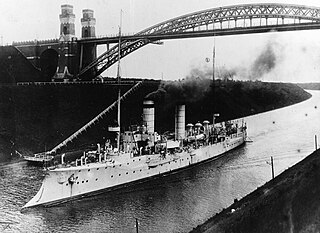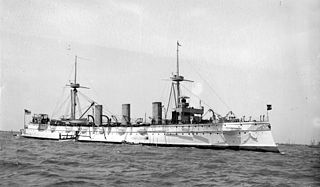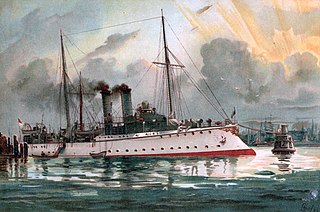
SMS Leipzig was the sixth of seven Bremen-class cruisers of the Imperial German Navy, named after the city of Leipzig. She was begun by AG Weser in Bremen in 1904, launched in March 1905 and commissioned in April 1906. Armed with a main battery of ten 10.5 cm (4.1 in) guns and two 45 cm (18 in) torpedo tubes, Leipzig was capable of a top speed of 22.5 knots.

The German East Asia Squadron was an Imperial German Navy cruiser squadron which operated mainly in the Pacific Ocean between the mid-1890s until 1914, when it was destroyed at the Battle of the Falkland Islands. It was based at Germany's Jiaozhou Bay Leased Territory in China.

The siege of Tsingtao was the attack on the German port of Qingdao (Tsingtao) during World War I by Japan and the United Kingdom. The siege was waged against Imperial Germany between 27 August and 7 November 1914. The siege was the first encounter between Japanese and German forces, the first Anglo-Japanese operation of the war, and the only major land battle in the Asian and Pacific theatre during World War I.

SMS Seeadler was an unprotected cruiser of the Bussard class, the third member of a class of six ships built by the German Kaiserliche Marine. Her sister ships included Bussard, the lead ship, along with Falke, Condor, Cormoran, and Geier. Seeadler was built at the Kaiserliche Werft in Danzig in late 1890, launched in February 1892, and commissioned in August of that year. Intended for colonial service, Seeadler was armed with a main battery of eight 10.5-centimeter (4.1 in) guns and had a top speed of 15.5 knots.

Asian and Pacific theatre of World War I consisted of various military engagements that took place on the Asian continent and on Pacific islands. They include naval battles, the Allied conquest of German colonial possessions in the Pacific Ocean and China, and an anti-Russian rebellion in Russian Turkestan and an Ottoman-supported rebellion in British Malaya. The most significant military action was the careful and well-executed Siege of Qingdao in China, but smaller actions were also fought at Bita Paka and Toma in German New Guinea.

SMS Eber was the last of the six gunboats of the Iltis class of the German Imperial Navy prior to and during World War I. Other ships of the class are SMS Iltis, SMS Luchs, SMS Tiger, SMS Jaguar and SMS Panther. They were built between 1898 and 1903. All of them served primarily overseas, in the German colonies. Eber had a crew of 9 officers and 121 men.

SMS Arcona was the ninth member of the ten-ship Gazelle class of light cruisers that were built for the German Kaiserliche Marine in the late 1890s and early 1900s. The Gazelle class was the culmination of earlier unprotected cruiser and aviso designs, combining the best aspects of both types in what became the progenitor of all future light cruisers of the Imperial fleet. Built to be able to serve with the main German fleet and as a colonial cruiser, she was armed with a battery of ten 10.5 cm (4.1 in) guns and a top speed of 21.5 knots. Arcona was a modified version of the basic Gazelle design, with improved armor and additional coal storage for a longer cruising range.

SMS Fürst Bismarck was Germany's first armored cruiser, built for the Kaiserliche Marine before the turn of the 20th century. The ship was named for the German statesman Otto von Bismarck. The design for Fürst Bismarck was an improvement over the previous Victoria Louise-class protected cruisers—Fürst Bismarck was significantly larger and better armed than her predecessors.

SMS Kaiserin Elisabeth was a Kaiser Franz Joseph I-class protected cruiser of the Austro-Hungarian Navy. Named in honor of the Empress Elisabeth, consort of Emperor Franz Josef, the cruiser was designed for overseas service and in fact was stationed in China at the outbreak of World War I in 1914.

SMS Kaiserin Augusta was a unique protected cruiser, built for the German Kaiserliche Marine in the early 1890s. Named for Empress Augusta, who died in January 1890, she was laid down in 1890, launched in January 1892, and completed in November of that year. Owing to budgetary restrictions, Kaiserin Augusta was designed to fill both fleet scout and colonial cruiser roles. The ship was initially armed with a main battery of four 15 cm (5.9 in) and eight 10.5 cm (4.1 in) guns, which by 1896 was replaced with twelve new model 15 cm guns. She was the first ship in the German Navy to feature a three-shaft propeller arrangement.

SMS Irene was a protected cruiser or Kreuzerkorvette of the German Imperial Navy and the lead ship of the Irene class. She had one sister, Prinzess Wilhelm; the two ships were the first protected cruisers built by the German Navy. Irene was laid down in 1886 at the AG Vulcan shipyard in Stettin, launched in July 1887, and commissioned into the fleet in May 1888. The cruiser was named after Princess Irene of Hesse and by Rhine, sister-in-law of Kaiser Wilhem II. As built, the ship was armed with a main battery of fourteen 15 cm (5.9 in) guns and had a top speed of 18 knots.

The German commerce raiders of World War I were surface vessels used by the Imperial German Navy for its Handelskrieg, a campaign against Allied seaborne trade. The ships comprised warships, principally cruisers, stationed in the German colonial empire before the war began, express liners commissioned as auxiliary cruisers and later, freighters outfitted as merchant raiders. These vessels had a number of successes and had a significant effect on Allied naval strategy, particularly in the early months of the war.

SMS Condor was an unprotected cruiser of the Imperial German Navy. She was the fourth member of the Bussard class, which included five other vessels. The cruiser's keel was laid down in Hamburg in 1891, she was launched in February 1892, and was commissioned in December of that year. Intended for overseas duty, Condor was armed with a main battery of eight 10.5-centimeter (4.1 in) guns, and could steam at a speed of 15.5 knots.

SMS Cormoran was an unprotected cruiser of the Bussard class, the fifth member of a class of six ships. She was built for the Imperial German Navy for overseas duty. The cruiser's keel was laid down in Danzig in 1890; she was launched in May 1892 and commissioned in July 1893. Cormoran was armed with a main battery of eight 10.5-centimeter (4.1 in) guns, and could steam at a speed of 15.5 knots.

SMS Iltis was the lead ship of the Iltis class of gunboats built for the German Kaiserliche Marine in the late 1890s and early 1900s. Other ships of the class are SMS Luchs, SMS Tiger, SMS Eber, SMS Jaguar, and SMS Panther.

SMS Luchs was the fourth member of the Iltis class of gunboats built for the German Kaiserliche Marine in the late 1890s and early 1900s. Other ships of the class are SMS Iltis, SMS Tiger, SMS Eber, SMS Jaguar and SMS Panther.

SMS Tiger was the third member of the Iltis class of gunboats built for the German Kaiserliche Marine in the late 1890s and early 1900s. Other ships of the class were SMS Iltis, SMS Luchs, SMS Eber, SMS Jaguar and SMS Panther.

SMS Arcona was a member of the Carola class of steam corvettes built for the German Kaiserliche Marine in the 1880s. Intended for service in the German colonial empire, the ship was designed with a combination of steam and sail power for extended range, and was equipped with a battery of ten 15-centimeter (5.9 in) guns. Arcona was laid down at the Kaiserliche Werft in Danzig in 1881, she was launched in May 1885, and she was completed in December 1886.



















